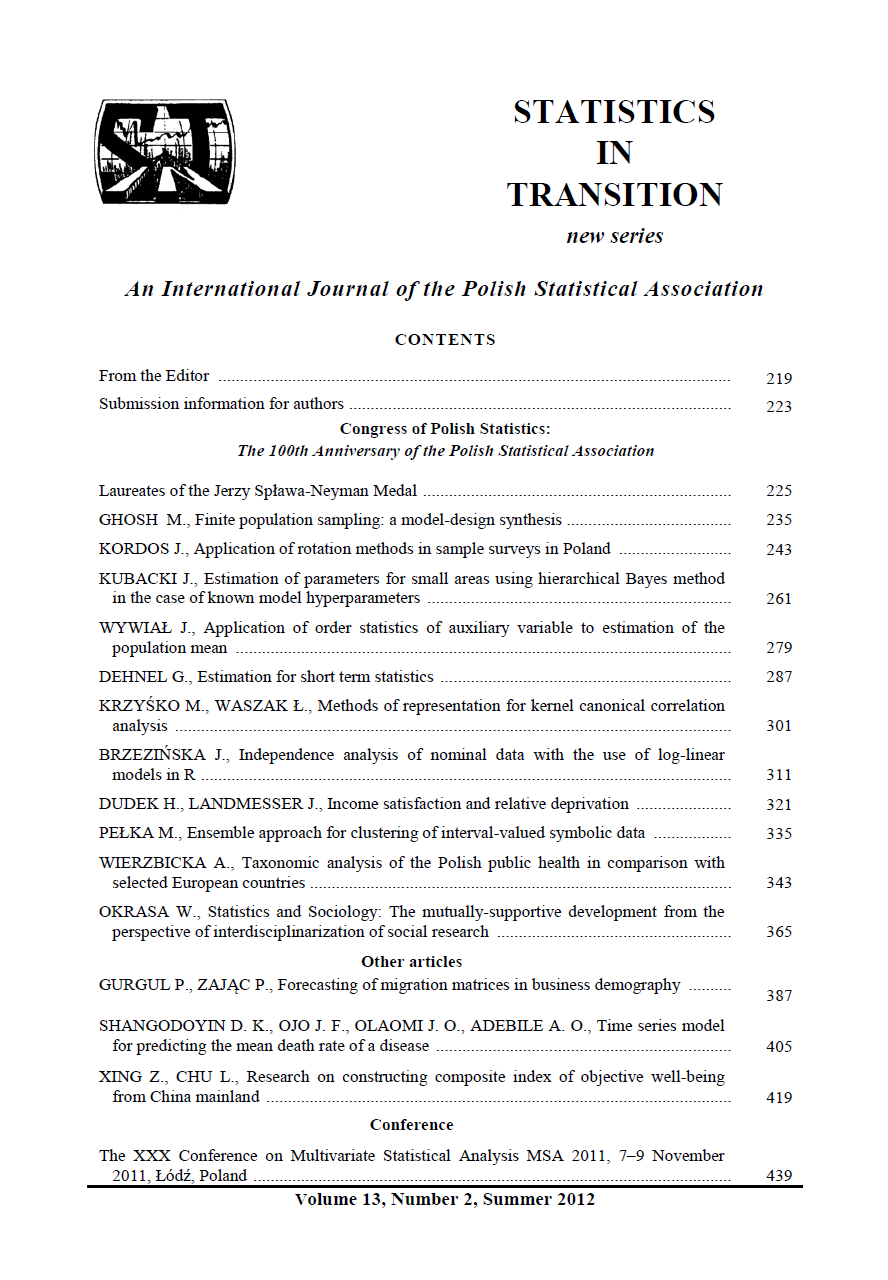ARTICLE
ABSTRACT
This paper presents some results of the study employing the Quality of Life (QOL) index that was initiated in China during 1980s. Currently, some progress has been made in the research field. For one thing, many researchers defined QOL as a composite structure which included subjective and objective elements. Considerable summary of well-being indices has been constructed from different analysis units (e.g., cities, province, and nations). For another, statistical methods played an important part in determining the weights of these indices, either objective weighting or subjective weighting. This paper defines the concept of QOL as the quality of people's being, which is used in analyzing the well-being of people' living condition and also reflected their subjective well-being to the living condition. Based on this concept, an analytical system of Chinese people's well-being was elaborated. 115 indices from five aspects reflecting the characteristics of the Chinese people's objective well-being have been initially proposed. Economic well-being, health and basic survival well-being, social well-being, cultural well-being, political well-being and environmental well-being have been taken into consideration. Through the analysis of content validity of experts and correlation analysis, 58 indices were selected. The weights of the subjective and objective indices were determined through analytic hierarchy process (AHP) and principal component method respectively. By combining the weight coefficients obtained from the two approaches, the composite indicator of Chinese people’s objective well-being was performed and the objective well-being level of 30 Chinese provinces was evaluated
KEYWORDS
Quality of life, Objective well-bell index, Analytic hierarchy process, China Mainland
REFERENCES
ALLARDT, E. (1993). Having, loving, being: An alternative to the Swedish model of welfare research, in M. Nussbaum and A. Sen (eds.), The Quality of Life (Oxford University Press, Oxford, pp. 88–94).
BANAI, R. (2005). Anthropocentric problem solving in planning and design, with analytic hierarchy process. J. Arch. Plann. Res, 22: 107-120. http://direct.bl.uk/bld/PlaceOrder.do?UIN=169190 608&ETOC=RN&from=searchengine.
CHEN, C., 2006. Applying the Analytical Hierarchy Process (AHP) approach to convention site selection. J. Travel Res., 45: 167-174.http://jtr.sagepub.com/cgi/reprint/45/2/167.
CHENG, E., LI, H. and YU, L. (2005). The Analytic Network Process (ANP) approach to location selection, A shopping mall illustration. Construct. Innovat., 5: 83-97. DOI: 10.1108/14714170510815195.
DIENER, E., & SUH, E. (1997). Measuring quality of life: Economic, social, and subjective indicators, Social Indicators Research, 40, 189–216.
Department of Environment, Food and Rural Affairs in UK (DEFRA) (2005), The wellbeing measurement in the national sustainable development indicators, http://www.defra.gov.uk/sustainable/government/progress/national/68.htm.
ERIKSON, R. (1993). Descriptions of inequality: The Swedish approach to welfare research, in M. Nussbaum and A. Sen. (eds.), The Quality of Life (Oxford University Press, Oxford, pp. 67-83).
FENG, X., YI S. (2000). The quality of family life in urban areas: indicators and the structures, Sociological Studies (Chinese), 4, 107-125.
JOLLIFFE, I.T.(2002). Principal component analysis, New York, Springer series in statistics, ISBN:0-387-95442-2, pp: 10-33.
LAWSHE, C.H. (1975). A quantitative approach to content validity. Personnel Psychology,28, 563-575.
LEE JAEHYUK, HAESEONG, J.E., JEONGSOO BYUN. (2011). Well-being index of super tall residential buildings in Korea, Building and Environment, 46, 1184-1194.
LIN, N., WANG L., PAN, Y., YUAN, G. (1989). The structures and the indicators of quality of life, Sociological Studies (Chinese), 6, 73-89.
LU, S. (1992). An analysis between marriage and quality of life of family in Chinese cities, Sociological Studies (Chinese), 4, 84-91.
SATTY, T.L. (1980). Analytic Hierarchy Process. New York, McGraw-Hill, ISBN: 096203178X, pp: 320.
SATTY, T.L. and K.P. KEARNS. (1985). Analytical Planning: The Organization of Systems. Pergamon, Oxford, ISBN: 0080325998, pp: 212.
SEDIGHEH LOTFI , KARIM SOLAIMANI. (2009). An assessment of Urban Quality of Life by Using Analytic Hierarchy Process Approach, Journal of Social Sciences, 5, 123-133.
SHEN, Q., LO K. and WANG, Q. (1998). Priority setting in maintenance:A modified multi-attribute approach using analytical hierarchy process. Construct. Manage. Econ., 16: 693-702. http://ideas.repec.org/a/taf/conmgt/v16y1998i6p693-702.html.
YUKSEL, I. and DAGDEVIREN, M. (2007). Using the Analytic Network Process (ANP) in a SWOT analysis - A case study for a textile firm. J. Inform. Sci., 177: 3364-3382. DOI: 10.1016/j.ins.2007.01.001.
UUSITALO, H. (1994). Social statistics and social reporting in the Nordic countries, in P. Flora, F. Kraus, H.-H. Noll and F. Rothenbacher (eds.), Social Statistics and Social Reporting in and for Europe (Informationszentrum Sozialwissenschaften, Bonn, pp. 99–120).
XING, Z., HUANG, L. (2007). An analysis of subjective well-being among major social groups: survey from the coastal province in China mainland, Social Sciences in Nanjing (Chinese), 1, 83-97.
ZAPF, W. (1984). Individuaelle Wohlfahrt: Lebensbedingungen und wahrgenommene Lebensqualität, in W. Glatzer and W. Zapf (eds.), Lebensqualität in der Bundesrepublik (Campus, Frankfurt a.M./New York, pp. 13–26).
ZHOU, C., CAI, J. (2004). Quality of life indicators: from subjective perspective, Wuhan University Journal (Philosophy and Social Sciences edition)(Chinese),5, 582-587
